A Novel MPPT Technique Based on Mutual Coordination between Two PV Modules/Arrays
Abstract
:1. Introduction
2. Distributed PV Systems and MPPT Techniques
2.1. Assumptions
2.2. MPPT Techniques
3. Basic Philosophy of Proposed Technique
Selection of Threshold Limit Values
4. Working of Proposed Technique
4.1. Stage 1 (Non-Mismatch Conditions)
4.1.1. Scenario 1: Uniform Irradiance Condition
4.1.2. Scenario 2: Varying Weather Condition
4.2. Stage 2 (Mismatch Conditions)
5. Concept Validation
Simulation Setup
6. Results and Discussion
6.1. Case 1: Step Increment in Weather Conditions
6.2. Case 2: Ramp Increment in Weather Conditions
6.3. Case 3
6.4. Case 4
6.5. Case 5
6.6. Summary
6.7. Partial Shading
6.7.1. Case 1
6.7.2. Case 2
7. Conclusions
Author Contributions
Funding
Institutional Review Board Statement
Informed Consent Statement
Data Availability Statement
Conflicts of Interest
Nomenclature
| Power difference between two PV modules/arrays | |
| Voltage step | |
| A1 | First PV Array |
| A2 | Second PV Array |
| Input capacitor | |
| Output capacitor | |
| CPV | Centralized Photovoltaic |
| D | Duty cycle |
| D-IC | Dual array based Incremental conductance MPPT |
| DPV | Distributed Photovoltaic |
| Current of PV module at MPP | |
| Short circuit current of PV module | |
| I-V | Current vs voltage characteristic curve |
| L | Inductor in dc-dc converter |
| MPPT | Maximum Power Point |
| Perturb and Observe | |
| PF | Power of the follower array |
| PS | Stored power |
| PL | Power of the leader array |
| P-V | Power vs voltage characteristic curve |
| PV | Photovoltaic |
| STC | Standard testing conditions |
| TH | Threshold value |
| THL | Threshold limit |
| Voltage of PV module at MPP | |
| Open circuit voltage of PV module |
References
- Adeel, M.; Hassan, A.K.; Sher, H.A.; Murtaza, A.F. A grade point average assessment of analytical and numerical methods for parameter extraction of a practical PV device. Renew. Sustain. Energy Rev. 2021, 142, 110826. [Google Scholar] [CrossRef]
- Ahmad, R.; Murtaza, A.F.; Sher, H.A.; Shami, U.T.; Olalekan, S. An analytical approach to study partial shading effects on PV array supported by literature. Renew. Sustain. Energy Rev. 2017, 74, 721–732. [Google Scholar] [CrossRef]
- Adinolfi, G.; Femia, N.; Petrone, G.; Spagnuolo, G.; Vitelli, M. Design of dc/dc Converters for DMPPT PV Applications Based on the Concept of Energetic Efficiency. J. Sol. Energy Eng. 2010, 132, 021005. [Google Scholar] [CrossRef]
- Chao, R.M.; Ko, S.H.; Lin, H.K.; Wang, I.K. Evaluation of a distributed photovoltaic system in grid-connected and standalone applications by different MPPT algorithms. Energies 2018, 11, 1484. [Google Scholar] [CrossRef] [Green Version]
- Ahmad, R.; Murtaza, A.F.; Sher, H.A. Power tracking techniques for efficient operation of photovoltaic array in solar applications—A review. Renew. Sustain. Energy Rev. 2019, 101, 82–102. [Google Scholar] [CrossRef]
- Park, J.H.; Ahn, J.Y.; Cho, B.H.; Yu, G.J. Dual-module-based maximum power point tracking control of photovoltaic systems. IEEE Trans. Ind. Electron. 2006, 53, 1036–1047. [Google Scholar] [CrossRef]
- Femia, N.; Lisi, G.; Petrone, G.; Spagnuolo, G.; Vitelli, M. Distributed maximum power point tracking of photovoltaic arrays: Novel approach and system analysis. IEEE Trans. Ind. Electron. 2008, 55, 2610–2621. [Google Scholar] [CrossRef] [Green Version]
- Delavaripour, H.; Dehkordi, B.M.; Zarchi, H.A.; Adib, E. Increasing energy capture from partially shaded PV string using differential power processing. IEEE Trans. Ind. Electron. 2018, 66, 7672–7682. [Google Scholar] [CrossRef]
- Petrone, G.; Spagnuolo, G.; Vitelli, M. An analog technique for distributed MPPT PV applications. IEEE Trans. Ind. Electron. 2011, 59, 4713–4722. [Google Scholar] [CrossRef]
- Murtaza, A.F.; Sher, H.A.; Chiaberge, M.; Boero, D.; De Giuseppe, M.; Addoweesh, K.E. Comparative analysis of maximum power point tracking techniques for PV applications. In Proceedings of the INMIC, Lahore, Pakistan, 19–20 December 2013; pp. 83–88. [Google Scholar]
- Petrone, G.; Ramos-Paja, C.A.; Spagnuolo, G.; Vitelli, M. Granular control of photovoltaic arrays by means of a multi-output Maximum Power Point Tracking algorithm. Prog. Photovolt. Res. Appl. 2013, 21, 918–932. [Google Scholar] [CrossRef]
- Miyatake, M.; Veerachary, M.; Toriumi, F.; Fujii, N.; Ko, H. Maximum power point tracking of multiple photovoltaic arrays: A PSO approach. IEEE Trans. Aerosp. Electron. Syst. 2011, 47, 367–380. [Google Scholar] [CrossRef]
- Renaudineau, H.; Donatantonio, F.; Fontchastagner, J.; Petrone, G.; Spagnuolo, G.; Martin, J.P.; Pierfederici, S. A PSO-based global MPPT technique for distributed PV power generation. IEEE Trans. Ind. Electron. 2014, 62, 1047–1058. [Google Scholar] [CrossRef]
- Sher, H.A.; Murtaza, A.F.; Noman, A.; Addoweesh, K.E.; Al-Haddad, K.; Chiaberge, M. A new sensorless hybrid MPPT algorithm based on fractional short-circuit current measurement and P&O MPPT. IEEE Trans. Sustain. Energy 2015, 6, 1426–1434. [Google Scholar]
- López-Erauskin, R.; González, A.; Petrone, G.; Spagnuolo, G.; Gyselinck, J. Multi-Variable Perturb and Observe Algorithm for Grid-Tied PV Systems With Joint Central and Distributed MPPT Configuration. IEEE Trans. Sustain. Energy 2020, 12, 360–367. [Google Scholar] [CrossRef]
- Sher, H.A.; Murtaza, A.F.; Addoweesh, K.E.; Chiaberge, M. A two stage hybrid maximum power point tracking technique for photovoltaic applications. In Proceedings of the 2014 IEEE PES General Meeting | Conference & Exposition, National Harbor, MD, USA, 27–31 July 2014; pp. 1–5. [Google Scholar]
- Petrone, G.; Spagnuolo, G.; Teodorescu, R.; Veerachary, M.; Vitelli, M. Reliability issues in photovoltaic power processing systems. IEEE Trans. Ind. Electron. 2008, 55, 2569–2580. [Google Scholar] [CrossRef]
- Kollimalla, S.K.; Mishra, M.K. Variable perturbation size adaptive P&O MPPT algorithm for sudden changes in irradiance. IEEE Trans. Sustain. Energy 2014, 5, 718–728. [Google Scholar]
- Jiang, Y.; Qahouq, J.A.A.; Haskew, T.A. Adaptive step size with adaptive-perturbation-frequency digital MPPT controller for a single-sensor photovoltaic solar system. IEEE Trans. Power Electron. 2012, 28, 3195–3205. [Google Scholar] [CrossRef]
- Killi, M.; Samanta, S. Modified perturb and observe MPPT algorithm for drift avoidance in photovoltaic systems. IEEE Trans. Ind. Electron. 2015, 62, 5549–5559. [Google Scholar] [CrossRef]
- Ahmed, J.; Salam, Z. A modified P&O maximum power point tracking method with reduced steady-state oscillation and improved tracking efficiency. IEEE Trans. Sustain. Energy 2016, 7, 1506–1515. [Google Scholar]
- Behera, T.K.; Behera, M.K.; Nayak, N. Spider monkey based improve P&O MPPT controller for photovoltaic generation system. In Proceedings of the 2018 Technologies for Smart-City Energy Security and Power (ICSESP), Bhubaneswar, India, 28–30 March 2018; pp. 1–6. [Google Scholar]
- Murtaza, A.F.; Sher, H.A.; Chiaberge, M.; Boero, D.; De Giuseppe, M.; Addoweesh, K.E. A novel hybrid MPPT technique for solar PV applications using perturb & observe and fractional open circuit voltage techniques. In Proceedings of the 15th International Conference MECHATRONIKA, Prague, Czech Republic, 5–7 December 2012; pp. 1–8. [Google Scholar]
- Sher, H.A.; Rizvi, A.A.; Addoweesh, K.E.; Al-Haddad, K. A single-stage stand-alone photovoltaic energy system with high tracking efficiency. IEEE Trans. Sustain. Energy 2016, 8, 755–762. [Google Scholar] [CrossRef]
- Sher, H.A.; Addoweesh, K.E.; Al-Haddad, K. An efficient and cost-effective hybrid MPPT method for a photovoltaic flyback microinverter. IEEE Trans. Sustain. Energy 2017, 9, 1137–1144. [Google Scholar] [CrossRef]
- Han, C.; Lee, H. Investigation and modeling of long-term mismatch loss of photovoltaic array. Renew. Energy 2018, 121, 521–527. [Google Scholar] [CrossRef]
- Grandi, G.; Ostojic, D. Dual-inverter-based MPPT algorithm for grid-connected photovoltaic systems. In Proceedings of the 2009 International Conference on Clean Electrical Power, Capri, Italy, 9–11 June 2009; pp. 393–398. [Google Scholar]
- Grandi, G.; Rossi, C.; Fantini, G. Modular photovoltaic generation systems based on a dual-panel MPPT algorithm. In Proceedings of the 2007 IEEE International Symposium on Industrial Electronics, Vigo, Spain, 4–7 June 2007; pp. 2432–2436. [Google Scholar]
- Chamberlin, C.E.; Lehman, P.; Zoellick, J.; Pauletto, G. Effects of mismatch losses in photovoltaic arrays. Sol. Energy 1995, 54, 165–171. [Google Scholar] [CrossRef]
- Spertino, F.; Akilimali, J.S. Are Manufacturing I–V Mismatch and Reverse Currents Key Factors in Large Photovoltaic Arrays? IEEE Trans. Ind. Electron. 2009, 56, 4520–4531. [Google Scholar] [CrossRef] [Green Version]
- Villalva, M.G.; Gazoli, J.R.; Ruppert Filho, E. Comprehensive approach to modeling and simulation of photovoltaic arrays. IEEE Trans. Power Electron. 2009, 24, 1198–1208. [Google Scholar] [CrossRef]


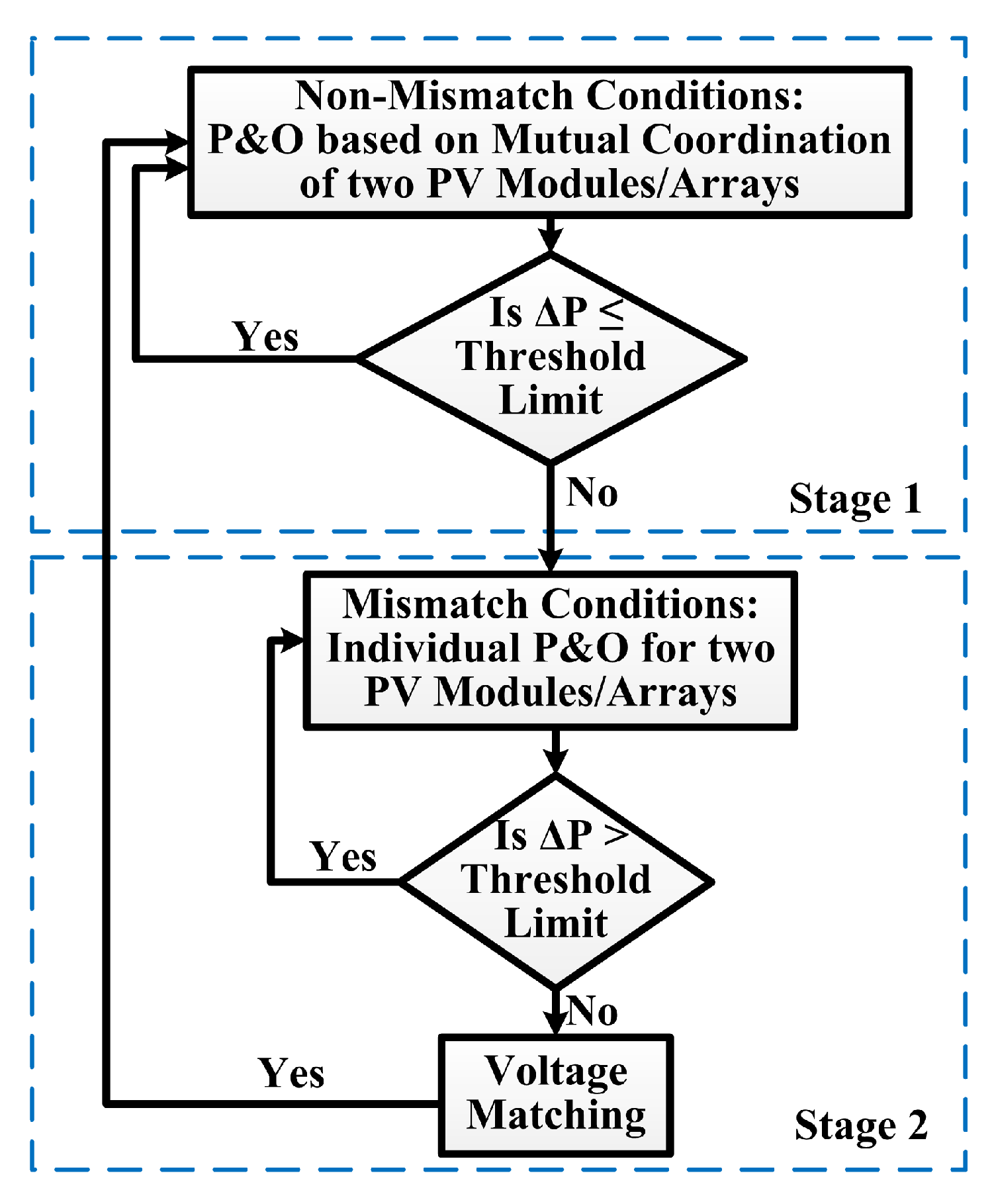
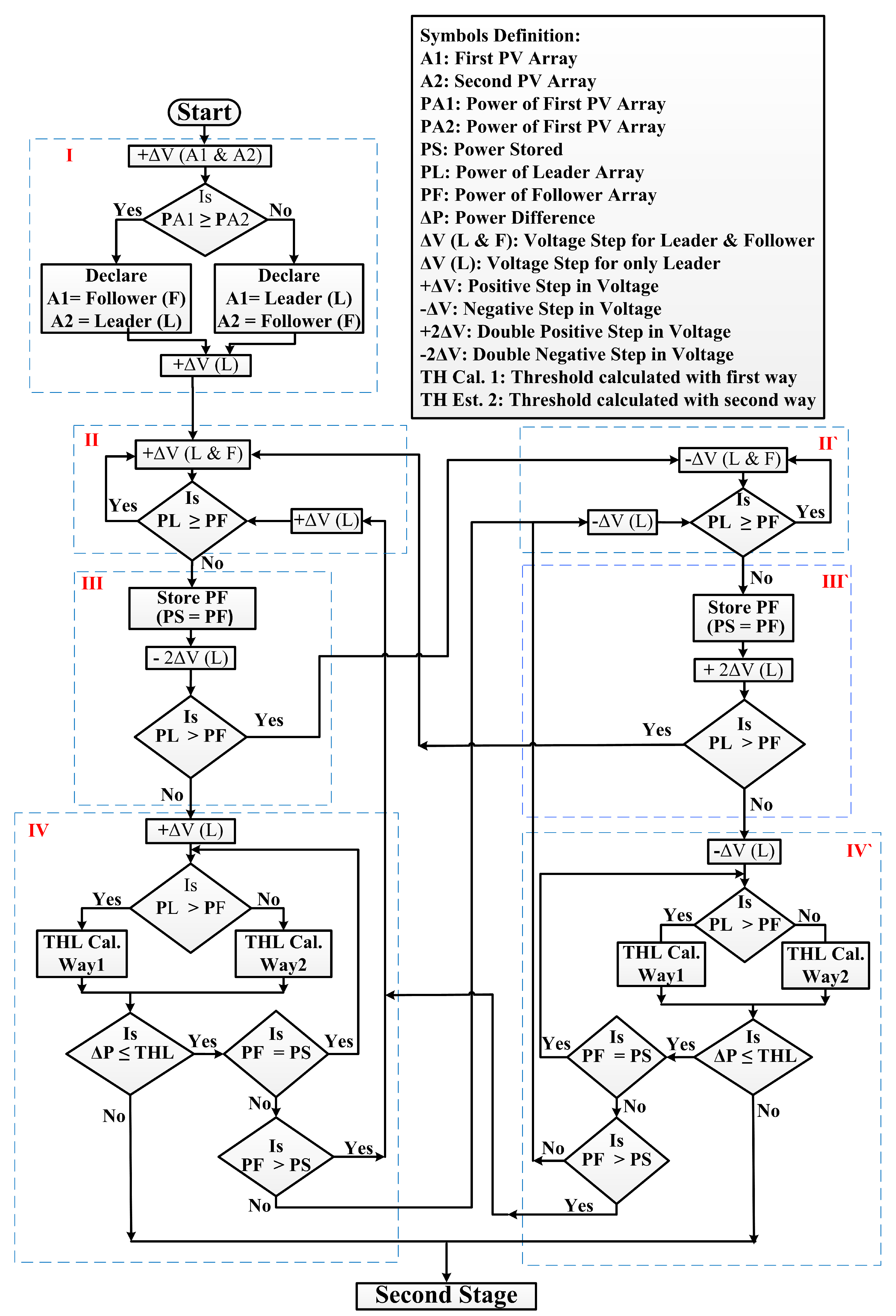
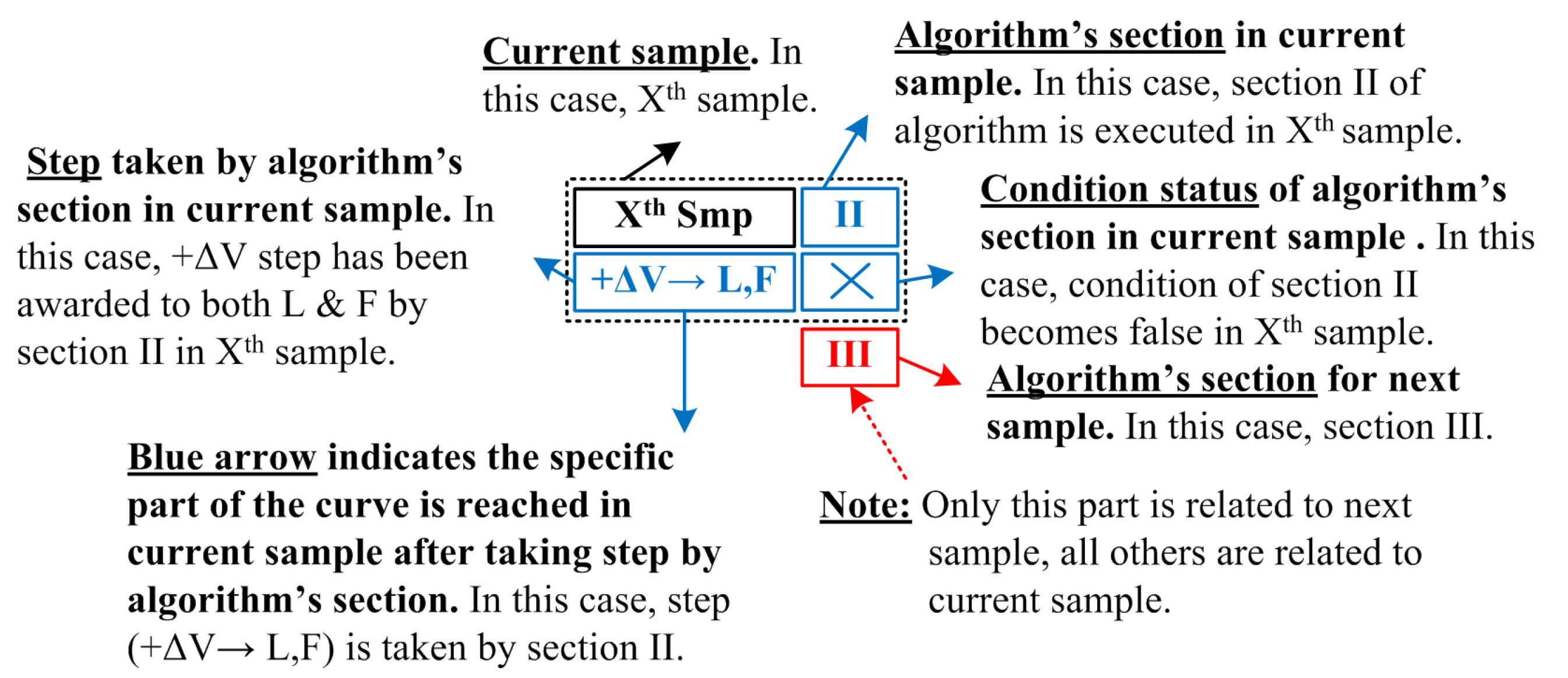

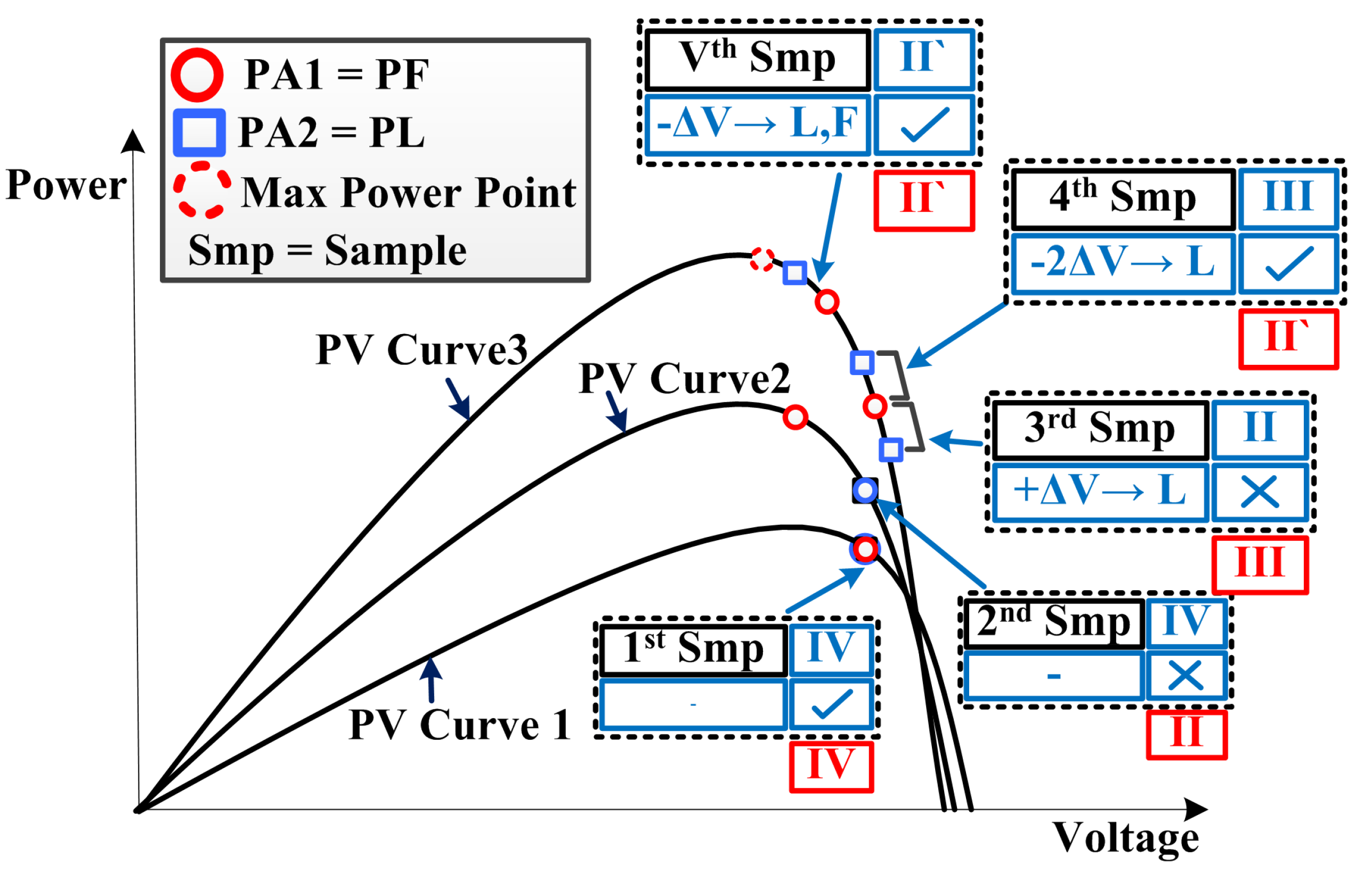
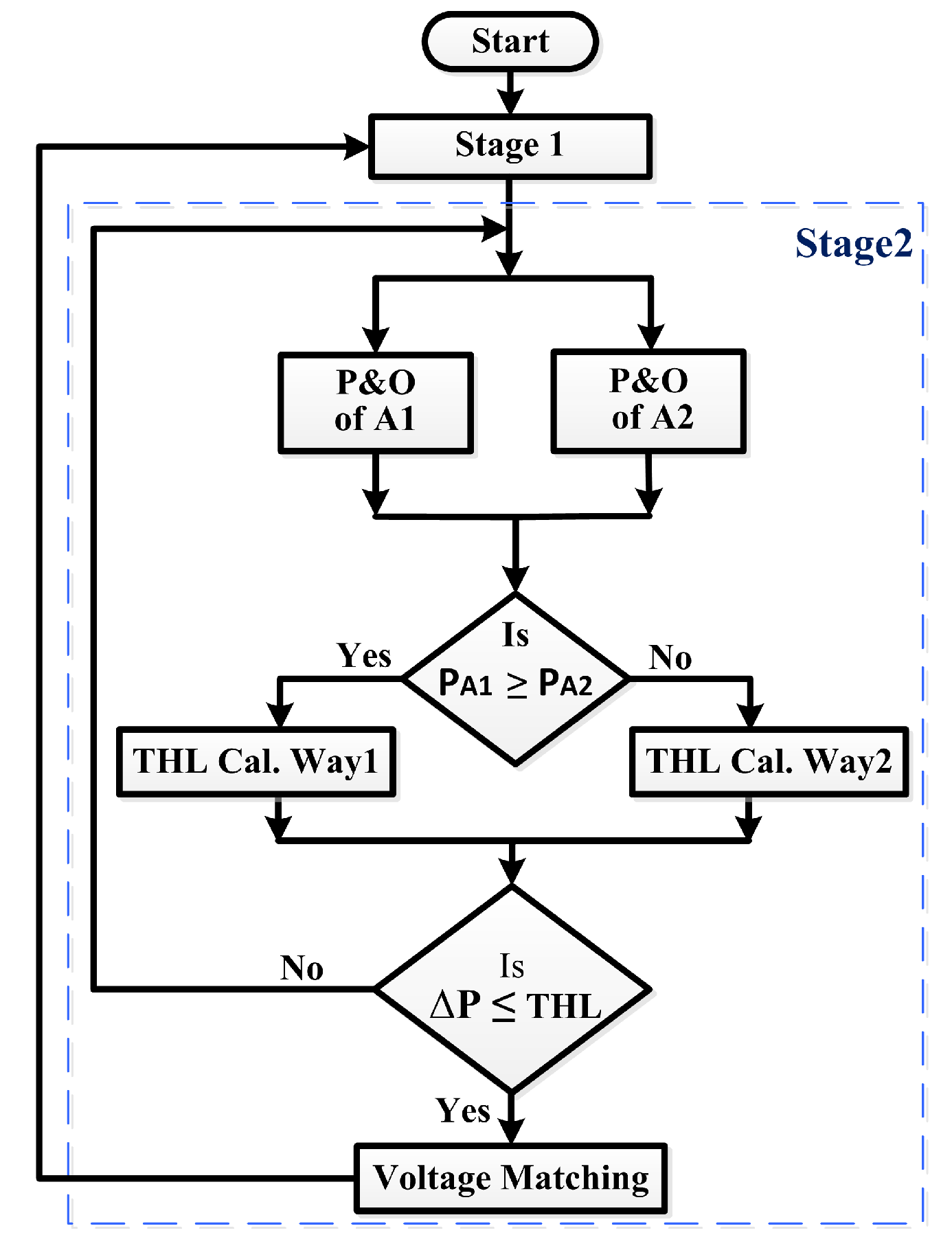

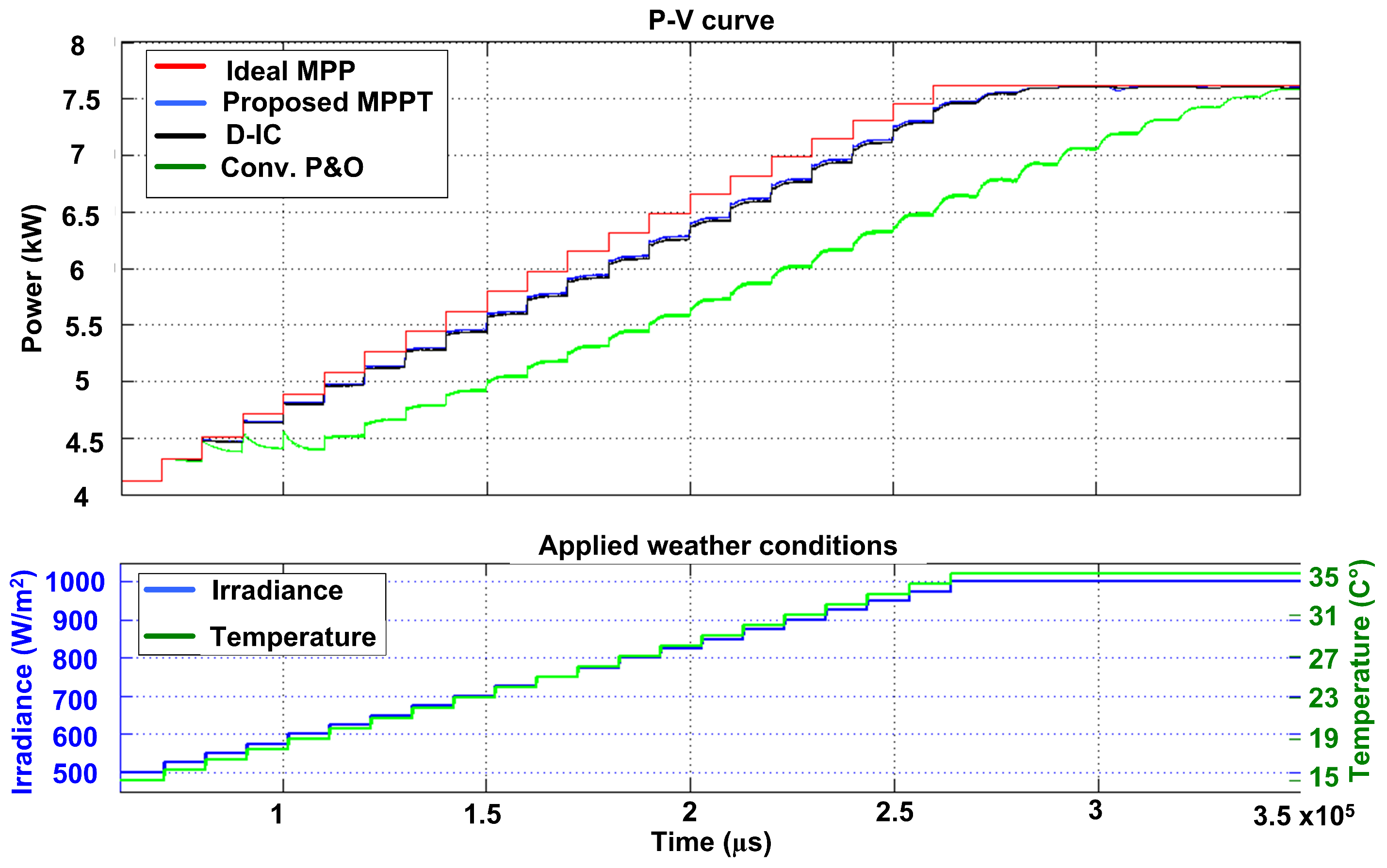
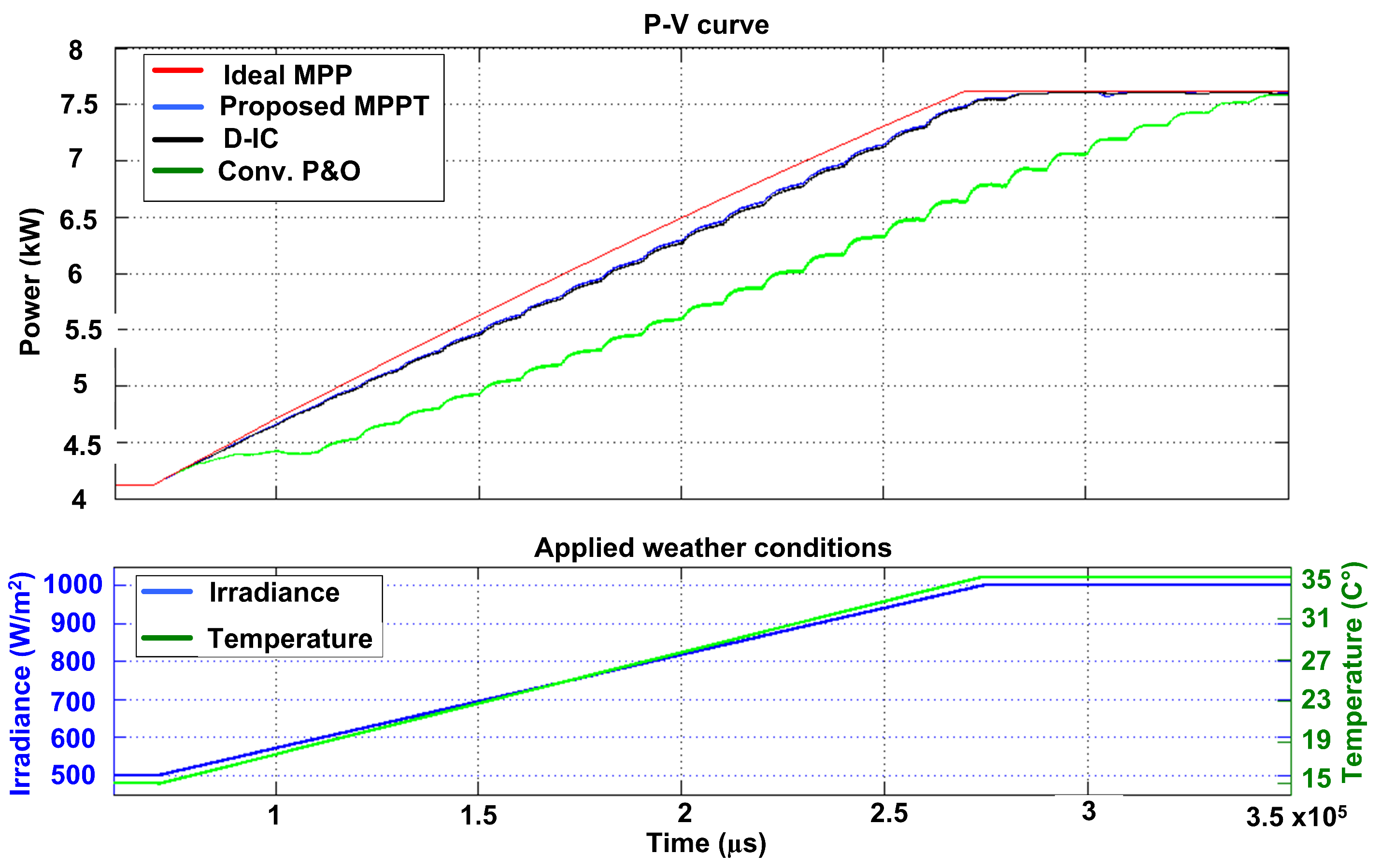
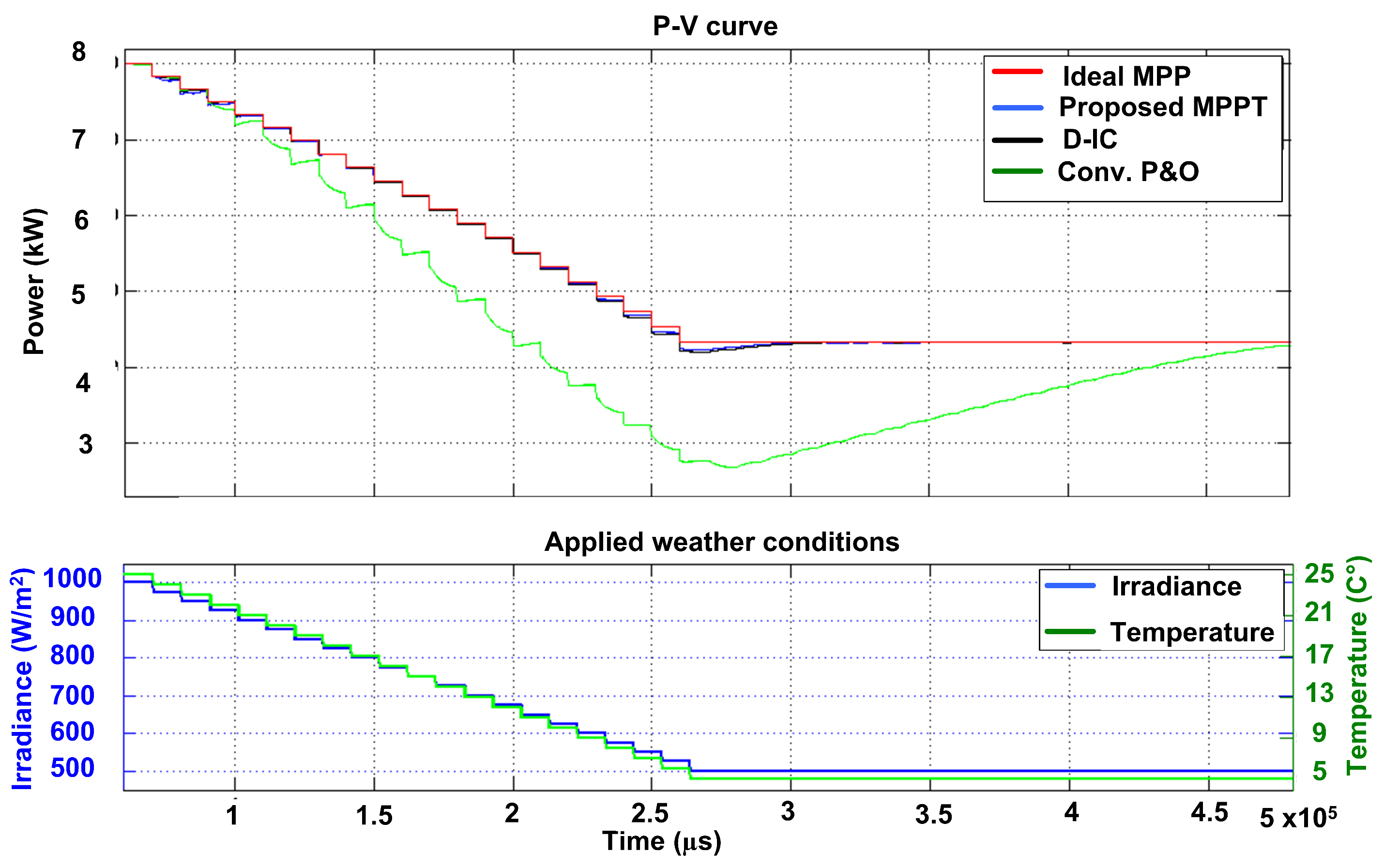
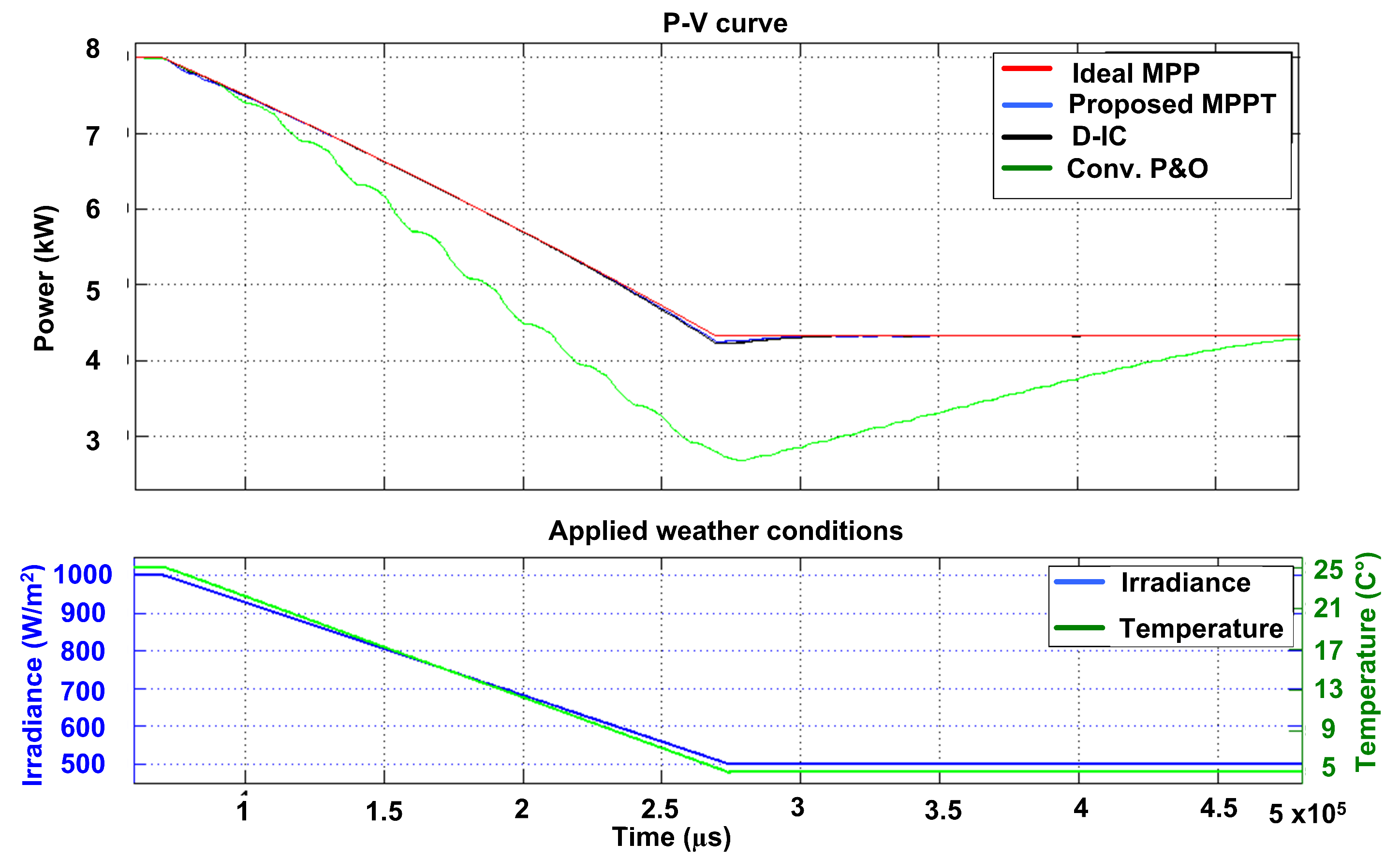
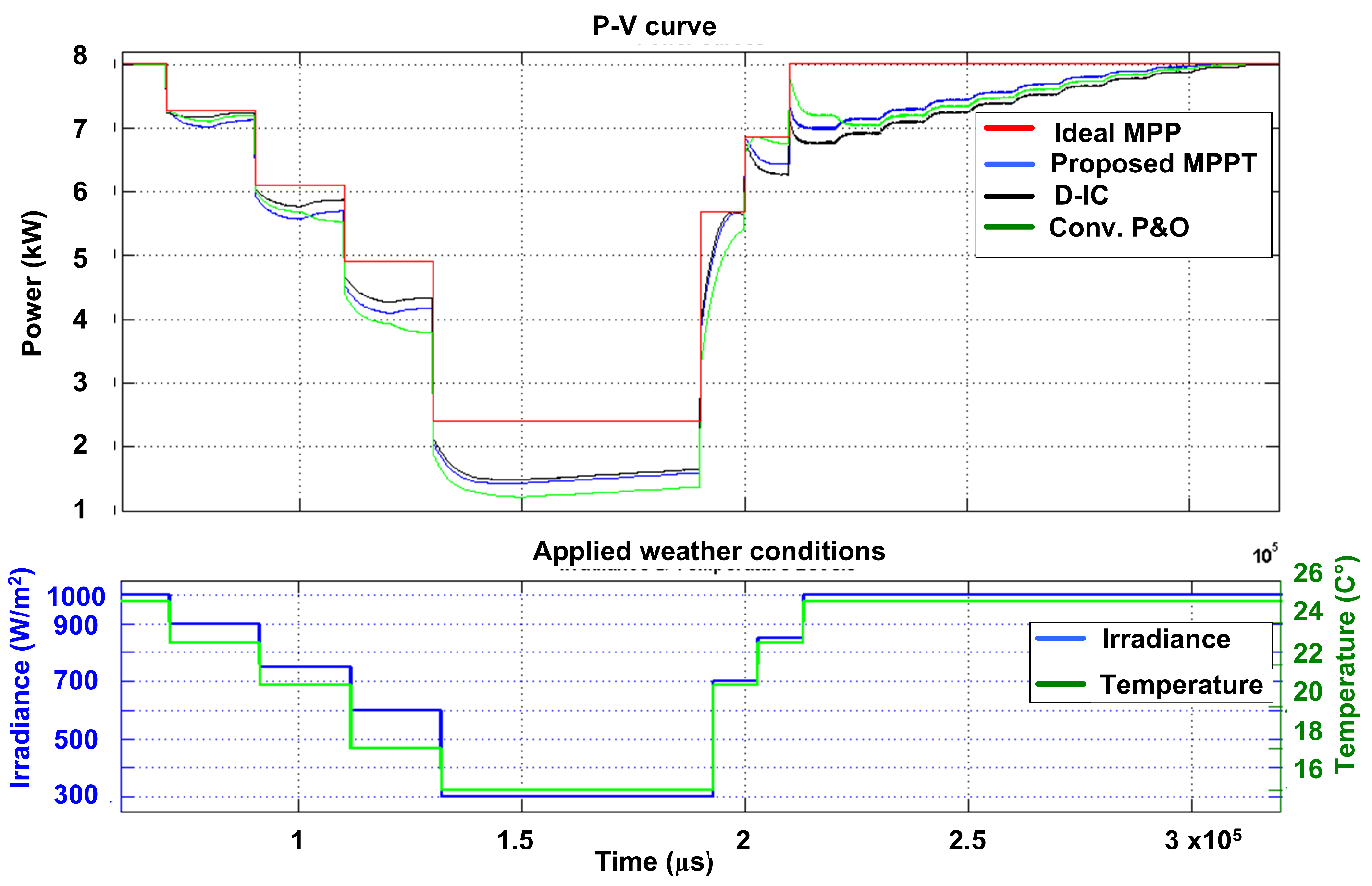
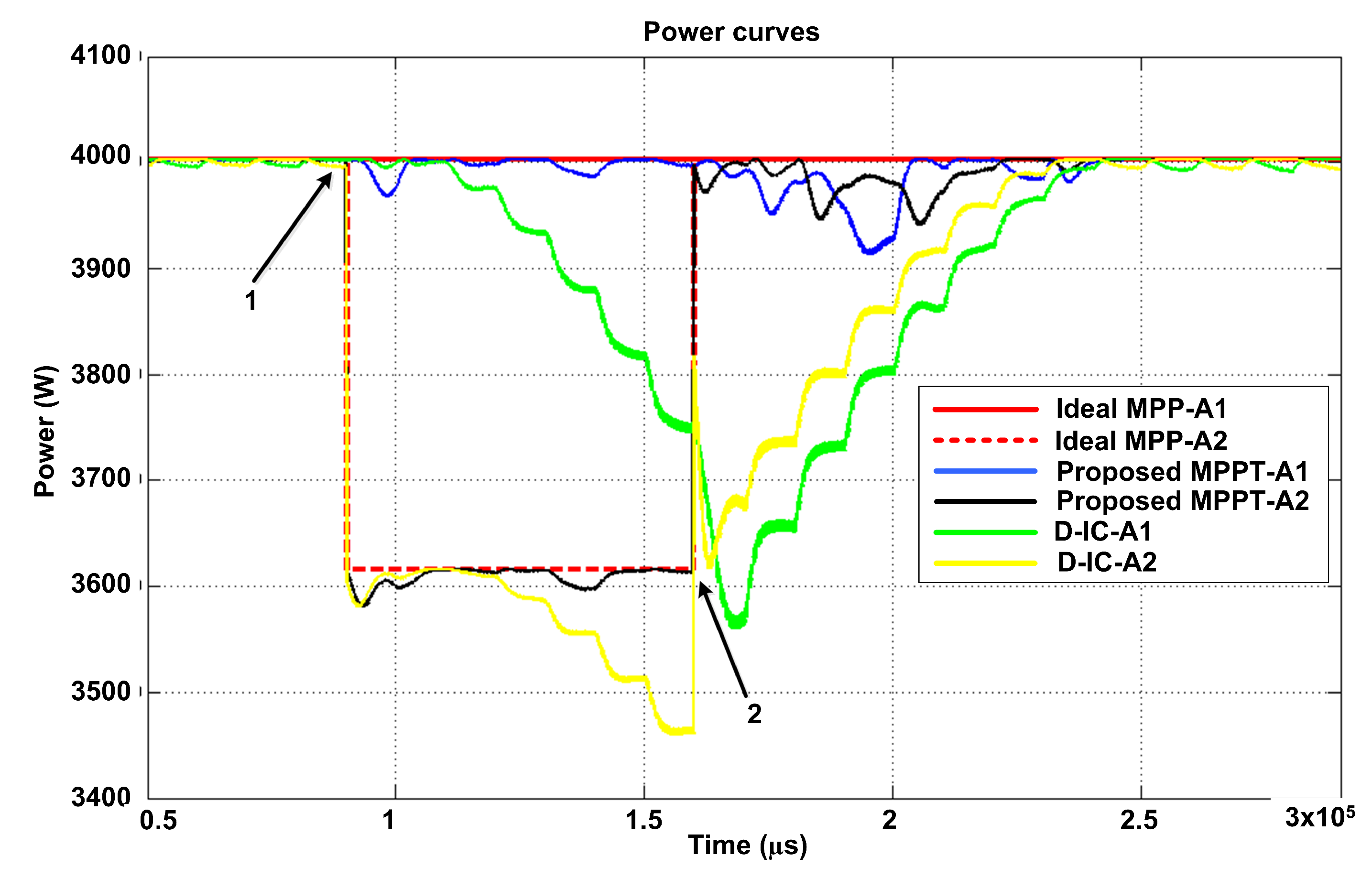
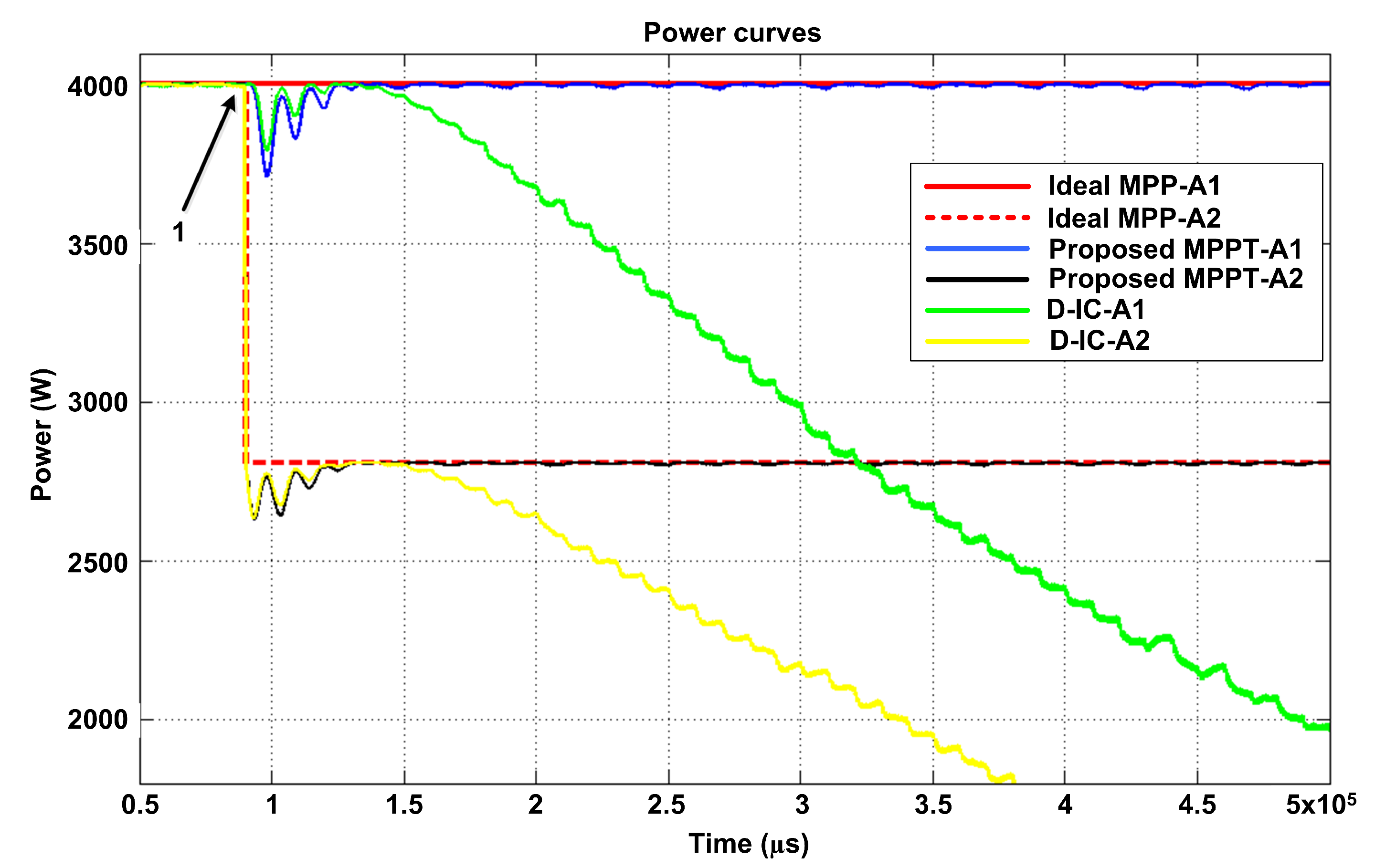
| No of Modules Per Array | Threshold Value Range |
|---|---|
| Greater than 12 | 0.3 to 0.7% |
| Greater than 1 and less than 12 | 0.8% to 1.3% |
| 1 | 1.4% to 1.7% |
| Parameters | Value |
|---|---|
| 8.21 | |
| 32.9 | |
| 7.61 | |
| 26.3 | |
| 200 | |
| −0.123 | |
| 0.0032 | |
| 54 |
| Case | Type | Measurement Period | Efficiency (%) proposed MPPT | Efficiency (%) D-IC | Efficiency (%) Conv. |
|---|---|---|---|---|---|
| 1 | Step rise | 70−350 ms | 98.21 | 97.98 | 90.91 |
| 2 | Ramp rise | 70−350 ms | 98.59 | 98.37 | 90.81 |
| 3 | Step decay | 70−480 ms | 99.66 | 99.6 | 84.46 |
| 4 | Ramp decay | 70−480 ms | 99.78 | 99.74 | 84.97 |
| 5 | Cloud pass | 70−320 ms | 91.31 | 91.06 | 89.95 |
Publisher’s Note: MDPI stays neutral with regard to jurisdictional claims in published maps and institutional affiliations. |
© 2021 by the authors. Licensee MDPI, Basel, Switzerland. This article is an open access article distributed under the terms and conditions of the Creative Commons Attribution (CC BY) license (https://creativecommons.org/licenses/by/4.0/).
Share and Cite
Murtaza, A.F.; Sher, H.A.; Spertino, F.; Ciocia, A.; Noman, A.M.; Al-Shamma’a, A.A.; Alkuhayli, A. A Novel MPPT Technique Based on Mutual Coordination between Two PV Modules/Arrays. Energies 2021, 14, 6996. https://doi.org/10.3390/en14216996
Murtaza AF, Sher HA, Spertino F, Ciocia A, Noman AM, Al-Shamma’a AA, Alkuhayli A. A Novel MPPT Technique Based on Mutual Coordination between Two PV Modules/Arrays. Energies. 2021; 14(21):6996. https://doi.org/10.3390/en14216996
Chicago/Turabian StyleMurtaza, Ali Faisal, Hadeed Ahmed Sher, Filippo Spertino, Alessandro Ciocia, Abdullah M. Noman, Abdullrahman A. Al-Shamma’a, and Abdulaziz Alkuhayli. 2021. "A Novel MPPT Technique Based on Mutual Coordination between Two PV Modules/Arrays" Energies 14, no. 21: 6996. https://doi.org/10.3390/en14216996
APA StyleMurtaza, A. F., Sher, H. A., Spertino, F., Ciocia, A., Noman, A. M., Al-Shamma’a, A. A., & Alkuhayli, A. (2021). A Novel MPPT Technique Based on Mutual Coordination between Two PV Modules/Arrays. Energies, 14(21), 6996. https://doi.org/10.3390/en14216996








